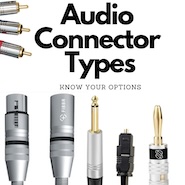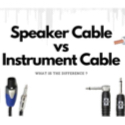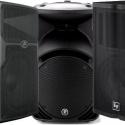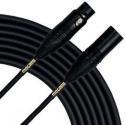Everything You Need to Know About Speaker Connector Types

If human beings need a connection to establish good relationships, so do your speakers. Speaker connector types serve as different conveyors to achieve high-quality, uninterrupted sound.
This is a definitive guide for musicians and sound engineers seeking the right speaker connector for their setup.
We will go through the widely used industry-standard connectors as well as the moderately used ones for older passive PA speakers and studio monitors.
Now, let's get down to the details.
Table of contents
-
How do speaker connectors work?
-
What speaker connectors are commonly used?
-
Seldom-used connector types
-
Which speaker connector type is right for me?
-
Final thoughts
-
FAQs
How do Speaker Connectors Work?
Speaker wire connectors house bare wires and provide a solid connection between amplifiers and speakers. A robust electric connection is made between your equipment and the speaker wire using a speaker connector.
The positive and negative terminals on audio systems and speakers are color-coded to indicate polarity. Positive terminals (+) are colored red, and negative terminals (-) are colored black.
Not all speaker wires include color coding or visible labels. They may use two-tone insulation for easier identification. The positive terminal, for instance, has stripes or dashed lines.
What Speaker Connectors are Commonly used?
These connectors are pretty common in professional audio speakers and live sound, studio music production, as well as home entertainment systems. Your connector type will depend on the specifications of the speakers, mixer, and audio interface you have.
Powered and passive speakers--powered or active speakers have built-in amplifiers, while passive speakers require an external power source.
For the most frequently used for professional audio, you have:
-
XLR connectors
-
TS/TRS 1/4-Inch connectors
-
Speakon connectors
-
Standard connectors with different ends
-
RCA connectors
Next, you have speaker connectors that are less frequently used, because they're for older speaker systems and passive monitor speakers, these are:
-
Banana plugs
-
Binding posts
-
Speaker pin connectors
-
Spade connectors
1. XLR Connectors
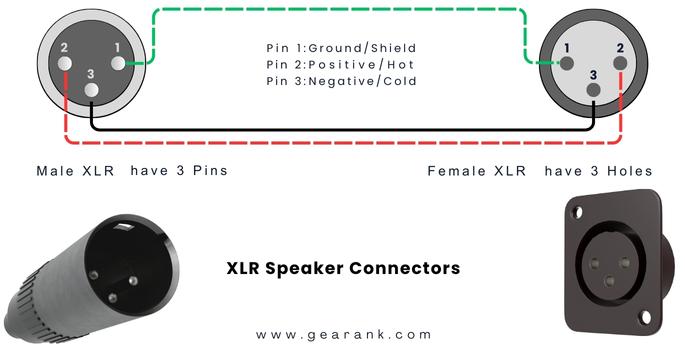
Used for: Powered PA and Studio Monitor Speakers
The XLR connectors are balanced connections that come in several designs. Three-pin designs are commonly used in pro audio. It's a standard connection for microphone cables and audio interfaces as well.
An XLR connector's pins have the following functions: Pin 1 is responsible for the ground/shield, and the first pin to get in contact. This lowers the chance of electromagnetic interference and excessive static noise. Pins 2 and 3 are responsible for the positive and negative signals.
The latch mechanism of the XLR cable safeguards it from accidental disconnections. The outer shell keeps the internal components from catching moisture and dust. This robust and reliable form is why they are a popular choice for gigs and concert speaker systems where outputting long-range signals is needed.
XLR is also used as for other digital signals like DMX for lighting devices.
2. TS and TRS ¼ Inch Connector
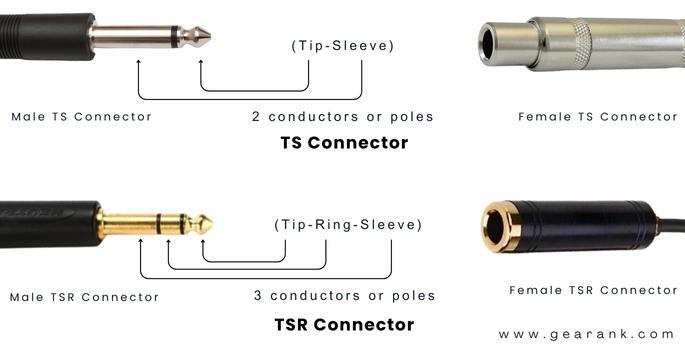
Used for: PA speakers (powered or passive), amplifiers, instruments
1/4 in connectors have been around since 1878 long before speakon connectors were invented. These connectors were originally made for telecommunications. Back then, phone operators would use these cables to connect a customer to the person they were calling.
Now, 1/4-inch connectors are widely used for audio and speaker connections between professional audio systems. This connector type comes in 2 versions: Balanced and unbalanced.
Balanced (TRS)
TRS (Tip, Ring, and Sleeve) audio connectors represent the three contacts. The pointed portion is the tip, followed by a black hoop. The tip and ring are responsible for the signals from the left and right channels.
Below them is a second black hoop which is then followed by the sleeve which functions as a ground shield. It's ideal for balanced signals like those coming from audio interfaces because this makes the signal less prone to outside interference.
Unbalanced (TS)
You'll often find them in guitar setups. Unbalanced connectors are typically used as a mono connection and it is only a tip and a sleeve. The tip is for the audio signal and the sleeve is for the ground.
You have two types of TS cables: instrument and speaker cables. While instrument and speaker cables look similar, both of them are constructed differently. Keep in mind that instrument cables are designed to carry low-voltage signals, while speaker cables have higher capacitance.
For better operating most audio equipment, you should also understand line-level signal.
3. Speakon Connectors
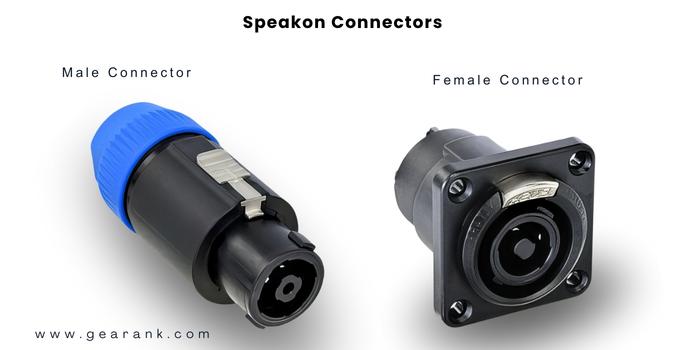
Used for: Powered & Passive PA Speakers, Subwoofers
Invented by Neutrik, Speakon connectors come in different varieties: 2 to 4 poles, and also an 8 pole version. These connectors were made in 1987 and have gradually reached popularity for over 3 decades.
While the 2 and 4 poles can be mated either way, an 8-pole Speakon connector is commonly used for bigger and more complex speaker systems because of their higher current capacity.
Newer versions of PA speakers and subwoofers use Speakon connectors because of their secure connection via their locking mechanism and non-shorting electric contact. This means when it's disconnected under load, it protects the speakers from getting damaged.
Pro audio engineers prefer Speakon connectors over TS or TRS connectors because they lock in place. It's a popular alternative because it prevents mixups from happening since TS cables and instrument cables look similar.
4. Standard connectors with different ends
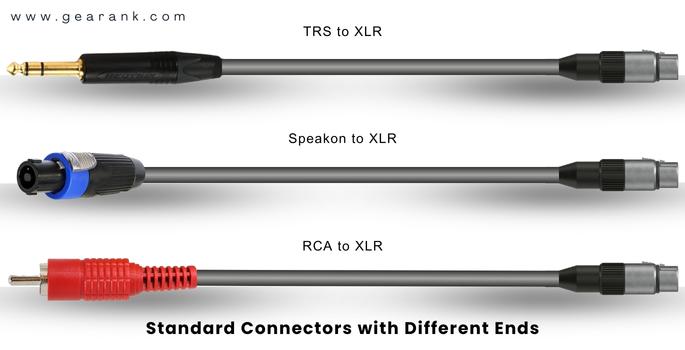
Used for: Interconnecting different pro audio systems with different connectors
Creating a solid connection between your mixer and speakers doesn't always have to be 1 type of connector.
Here are the most pairs for live sound and studio audio:
-
TRS to XLR
-
Speakon to XLR
-
RCA to XLR
Different connectors are more resilient against accidental disconnections. For instance, passive PA speakers will use a speakon connector while the other end uses a male or female XLR. It serves as a compatible connection between different equipment like mixers, power amplifiers, and speakers.
5. RCA Connectors
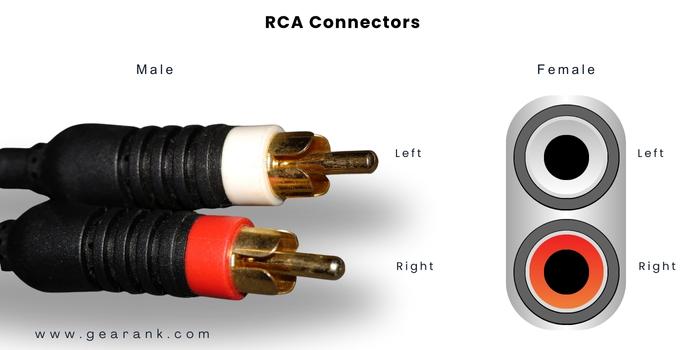
Used for: Older subwoofers and Monitor speakers
An RCA connector is sometimes referred to as a “phono connector.” Dating back to the 1940s, this connector was originally intended to connect a phonograph turntable to a radio receiver. Today, this basic analog audio connector is used for amplifiers, preamplifiers, and receivers. You'll often find RCA cables in studio setups, for connecting to monitor speakers.
Each of the jacks is color-coded to easily connect the speaker wire to the output. Red goes to the right channel, and black or white goes to the left.
Earlier models of subwoofers and speakers have used RCA connectors, but manufacturers have tilted their designs toward XLRs and Speakon connectors.
Less Common Speaker Connector Types
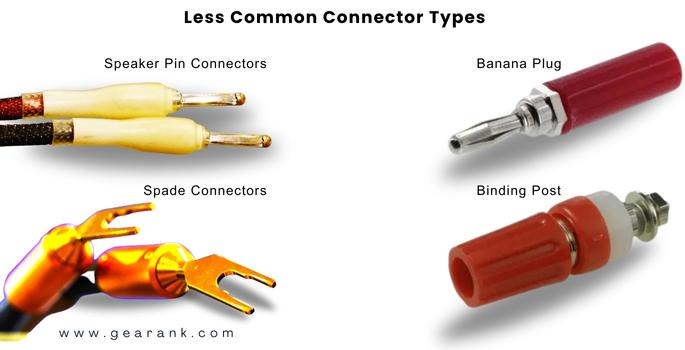
These connector types are rarely used for professional audio connections. Various audio equipment, like older passive monitor speakers, power amplifiers, and older PA speakers may still use these audio connector types.
6. Banana Plugs
Used for: Speaker amps and passive speakers with binding posts
You would find a banana plug mostly in hi-fi systems, but you can see them in most passive speakers as well. Though they're not as frequently used anymore, banana plugs are required if a speaker has binding-post terminals. Banana plugs have flexible metal "leaves" that compress when inserted into the terminals.
These plugs usually come with 4 or 9 leaves. The 9-leaf version offers better "grip" and it also has a more aesthetic design compared to other connectors. The connections for dual banana plugs are secured inside a plastic casing that separates them by 3/4” from one another.
7. Binding Post / Speaker Terminals
Used for: older amps and passive speakers
Older speakers work have binding posts or speaker terminals where you simply insert a bare speaker wire. But they can also be paired with pin, spade, or banana connectors.
Some terminals are spring based, while others are screw based. The binding post's hole should be filled with wire. Some terminals are compatible with banana plugs, you just have to remove the plastic cap of the receiver.
8. Speaker Pin Connectors
Used for: Speaker amps and passive speakers with binding posts.
Compared to banana plugs, the speaker pin is seen as a scaled-down version. They are less likely to stay in the connection port since they don't have spring contact. These pin connectors need to be firmly attached to binding posts as well.
Pin connectors work well, but they are also uncommon to find for speakers.
9. Spade Connectors
Used for: Wall-mounted speakers, Old combo amps.
A single wire requires 4 spade connectors. Spade connections come in both straight and angled varieties. However, there isn't much of a distinction between them.
These connectors have a metal forked appearance and are typically offered in sets.
This is the type of connector you'll see in older combo amps, used to connect the amplifier section with the built-in woofer.
For attaching wires to speakers close to a wall, spade connections are often the best choice.
Which Speaker Connector Type is Right for Me?
I went ahead and took out the guesswork and made a chart for you. Each of these cables or speaker wire connectors is based on the likely setup you'll have. This includes the type of instruments, equipment, or audio interface you're using.
It's important to keep in mind also that there are gears out there that are an exception to the rules. These are helpful, general guidelines that will save you a lot of headache in the long run.
See which category you fall into:
-
Musician
-
Live sound engineer
-
Studio engineer
Between each category, there's always going to be an overlap with the connectors that are used. It's useful to differentiate them like this because it prevents the endless search for cables. All that's left is to look at the chart and buy the speaker connectors.
Musician
You would need:
-
1/4 inch TS or speaker cable for connecting amps to guitar speakers
-
XLR connectors for connecting to stage monitors
-
1/4 inch Speaker cable for connecting amps to speaker cabinets
Live Sound Engineer
-
Speakon cables for PA speakers and subwoofers
-
XLR connectors for connecting mixing boards to PA speakers and stage monitors
-
1/4 inch (TS) for connecting amps to PA speakers, and stage monitors.
-
1/4 inch Speaker cable for connecting amps to speaker cabinets
Studio Engineer
-
XLR connectors for connecting powered or active studio monitor speakers.
-
RCA cable to aux for connecting to older studio monitor speakers.
-
Binding posts, banana plugs, and spade connectors for connecting to passive speaker cabs and monitor speakers.
-
1/4 inch TRS for connecting active monitor speakers with line output.
-
1/4 inch Speaker cable for connecting amps to speaker cabinets
Active and passive speakers have their own category because they use different speaker wire connectors.
In summary, active speakers, regardless of whether it's PA or powered studio monitor speakers, would most likely use XLR, Speakon, and 1/4-Inch TRS cable.
On the other hand, passive speakers found in older studio monitors, speaker cabinets, and combo amplifiers will use binding posts, banana plugs, speaker pin, and spade connectors.
Aside from the above mentioned cables, some modern PA speakers support digital audio connections.
Final Thoughts
Armed with the knowledge of speaker connector types, you can now figure out which connector is suited to your sound system.
XLR, Speakon, 1/4-inch connectors, and RCA are used in standard pro audio applications.
On the other hand, older passive speakers and even consumer audio equipment with binding post terminals can interface with spade connectors and banana plugs.
The types of speaker connector you'll be using will depend mostly on your existing, or planned sound setup.
Frequently Asked Questions
What Happens if You use a speaker cable as a guitar cable?
Chances are, you will damage your equipment because instrument cables are not built to handle higher power. At worst, if the amplifier is turned up significantly, it could potentially melt the wires.
Conversely, using a speaker cable as an instrument cable for your guitar will introduce a significant amount of noise.
Speaker cables are unshielded and have thicker wire gauge to handle high power, while instrument cables are shielded and have smaller gauges.
Speaker cables and instrument cables may look the same, but instrument and speaker audio cables are different by design.
Which one is better bare wires or banana or spade plugs?
For older passive monitors or even hi-fi systems, it's better to use speaker cable connectors or plugs that can shield the wires from unwanted interference or noise. Connectors also lower the chances of accidental snags which can damage your wires and equipment.
Which one has better sound quality XLR or 1/4 inch cable?
There's not much difference in terms of sound quality if we're comparing an XLR connector and TRS connector. Unbalanced connectors might introduce some static noise. Versatility-wise, XLR connectors are useful for mics and carry 48V phantom power. A good understanding of Line level vs instrument level will help when dealing with this question. Don't neglect to regularly check the wires and do a speaker test.
Contributors:
Allen Articulo - Co-writer
Jerry Borillo - Illustrator



